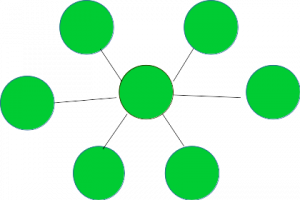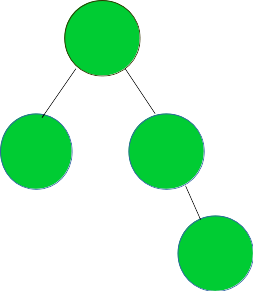给定图形G ,任务是检查它是否表示星形拓扑。
下图显示了一种星形拓扑:

例子:
Input : Graph = 
Output : YES
Input : Graph =
Output : NO如果满足以下三个条件,则V顶点的图表示星形拓扑:
- 一个节点(也称为中央节点)的度数为V – 1。
- 除中央节点外,所有节点的度数均为1。
- 边数=顶点数– 1。
想法是遍历图形并检查其是否满足以上三个条件。如果是,则表示星形拓扑。
下面是上述方法的实现:
CPP
// CPP program to check if the given graph
// represents a Star Topology
#include
using namespace std;
// A utility function to add an edge in an
// undirected graph.
void addEdge(vector adj[], int u, int v)
{
adj[u].push_back(v);
adj[v].push_back(u);
}
// A utility function to print the adjacency list
// representation of graph
void printGraph(vector adj[], int V)
{
for (int v = 0; v < V; ++v) {
cout << "\n Adjacency list of vertex "
<< v << "\n head ";
for (auto x : adj[v])
cout << "-> " << x;
printf("\n");
}
}
/* Function to return true if the graph represented
by the adjacency list represents a Star topology
else return false */
bool checkStarTopologyUtil(vector adj[], int V, int E)
{
// Number of edges should be equal
// to (Number of vertices - 1)
if (E != (V - 1))
return false;
// a single node is termed as a star topology
// having only a central node
if (V == 1)
return true;
int* vertexDegree = new int[V + 1];
memset(vertexDegree, 0, sizeof vertexDegree);
// calculate the degree of each vertex
for (int i = 1; i <= V; i++) {
for (auto v : adj[i]) {
vertexDegree[v]++;
}
}
// countCentralNodes strores the count of nodes
// with degree V - 1, which should be equal to 1
// in case of star topology
int countCentralNodes = 0, centralNode = 0;
for (int i = 1; i <= V; i++) {
if (vertexDegree[i] == (V - 1)) {
countCentralNodes++;
// Store the index of the central node
centralNode = i;
}
}
// there should be only one central node
// in the star topology
if (countCentralNodes != 1)
return false;
for (int i = 1; i <= V; i++) {
// except for the central node
// check if all other nodes have
// degree 1, if not return false
if (i == centralNode)
continue;
if (vertexDegree[i] != 1) {
return false;
}
}
// if all three necessary
// conditions as discussed,
// satisfy return true
return true;
}
// Function to check if the graph
// represents a Star topology
void checkStarTopology(vector adj[], int V, int E)
{
bool isStar = checkStarTopologyUtil(adj, V, E);
if (isStar) {
cout << "YES" << endl;
}
else {
cout << "NO" << endl;
}
}
// Driver code
int main()
{
// Graph 1
int V = 5, E = 4;
vector adj1[V + 1];
addEdge(adj1, 1, 2);
addEdge(adj1, 1, 3);
addEdge(adj1, 1, 4);
addEdge(adj1, 1, 5);
checkStarTopology(adj1, V, E);
// Graph 2
V = 5, E = 4;
vector adj2[V + 1];
addEdge(adj2, 1, 2);
addEdge(adj2, 1, 3);
addEdge(adj2, 3, 4);
addEdge(adj2, 4, 5);
checkStarTopology(adj2, V, E);
return 0;
} Java
// Java program to check if the given graph
// represents a star topology
import java.io.*;
import java.util.*;
class GFG
{
// A utility function to add an edge in an
// undirected graph.
static void addEdge(ArrayList> adj, int u, int v)
{
adj.get(u).add(v);
adj.get(v).add(u);
}
// A utility function to print the adjacency list
// representation of graph
static void printGraph(ArrayList> adj, int V)
{
for (int v = 0; v < V; ++v)
{
System.out.print("\n Adjacency list of vertex " +
v + "\n head ");
for (int x : adj.get(v))
{
System.out.print( "-> " + x);
}
System.out.println();
}
}
/* Function to return true if the graph represented
by the adjacency list represents a Star topology
else return false */
static boolean checkStarTopologyUtil(ArrayList> adj, int V, int E)
{
// Number of edges should be equal
// to (Number of vertices - 1)
if (E != (V - 1))
{
return false;
}
// a single node is termed as a star topology
// having only a central node
if (V == 1)
{
return true;
}
int[] vertexDegree = new int[V + 1];
// calculate the degree of each vertex
for (int i = 1; i <= V; i++)
{
for (int v : adj.get(i))
{
vertexDegree[v]++;
}
}
// countCentralNodes strores the count of nodes
// with degree V - 1, which should be equal to 1
// in case of star topology
int countCentralNodes = 0, centralNode = 0;
for (int i = 1; i <= V; i++)
{
if (vertexDegree[i] == (V - 1))
{
countCentralNodes++;
// Store the index of the central node
centralNode = i;
}
}
// there should be only one central node
// in the star topology
if (countCentralNodes != 1)
return false;
for (int i = 1; i <= V; i++)
{
// except for the central node
// check if all other nodes have
// degree 1, if not return false
if (i == centralNode)
continue;
if (vertexDegree[i] != 1)
{
return false;
}
}
// if all three necessary
// conditions as discussed,
// satisfy return true
return true;
}
// Function to check if the graph
// represents a Star topology
static void checkStarTopology(ArrayList> adj, int V, int E)
{
boolean isStar = checkStarTopologyUtil(adj, V, E);
if (isStar)
{
System.out.println("YES");
}
else
{
System.out.println("NO");
}
}
// Driver code
public static void main (String[] args)
{
// Graph 1
int V = 5, E = 4;
ArrayList> adj1 =
new ArrayList>();
for(int i = 0; i < V + 1; i++)
{
adj1.add(new ArrayList());
}
addEdge(adj1, 1, 2);
addEdge(adj1, 1, 3);
addEdge(adj1, 1, 4);
addEdge(adj1, 1, 5);
checkStarTopology(adj1, V, E);
// Graph 2
V = 5;
E = 4;
ArrayList> adj2 =
new ArrayList>();
for(int i = 0; i < (V + 1); i++)
{
adj2.add(new ArrayList());
}
addEdge(adj2, 1, 2);
addEdge(adj2, 1, 3);
addEdge(adj2, 3, 4);
addEdge(adj2, 4, 5);
checkStarTopology(adj2, V, E);
}
}
// This code is contributed by rag2127 Python3
# Python3 program to check if the given graph
# represents a star topology
# A utility function to add an edge in an
# undirected graph.
def addEdge(adj, u, v):
adj[u].append(v)
adj[v].append(u)
# A utility function to print the adjacency list
# representation of graph
def printGraph(adj, V):
for v in range(V):
print("Adjacency list of vertex ",v,"\n head ")
for x in adj[v]:
print("-> ",x,end=" ")
printf()
# /* Function to return true if the graph represented
# by the adjacency list represents a star topology
# else return false */
def checkStarTopologyUtil(adj, V, E):
# Number of edges should be equal
# to (Number of vertices - 1)
if (E != (V - 1)):
return False
# a single node is termed as a bus topology
if (V == 1):
return True
vertexDegree = [0]*(V + 1)
# calculate the degree of each vertex
for i in range(V+1):
for v in adj[i]:
vertexDegree[v] += 1
# countCentralNodes strores the count of nodes
# with degree V - 1, which should be equal to 1
# in case of star topology
countCentralNodes = 0
centralNode = 0
for i in range(1, V + 1):
if (vertexDegree[i] == (V - 1)):
countCentralNodes += 1
# Store the index of the central node
centralNode = i
# there should be only one central node
# in the star topology
if (countCentralNodes != 1):
return False
for i in range(1, V + 1):
# except for the central node
# check if all other nodes have
# degree 1, if not return false
if (i == centralNode):
continue
if (vertexDegree[i] != 1):
return False
# if all three necessary
# conditions as discussed,
# satisfy return true
return True
# Function to check if the graph represents a bus topology
def checkStarTopology(adj, V, E):
isStar = checkStarTopologyUtil(adj, V, E)
if (isStar):
print("YES")
else:
print("NO" )
# Driver code
# Graph 1
V, E = 5, 4
adj1=[[] for i in range(V + 1)]
addEdge(adj1, 1, 2)
addEdge(adj1, 1, 3)
addEdge(adj1, 1, 4)
addEdge(adj1, 1, 5)
checkStarTopology(adj1, V, E)
# Graph 2
V, E = 4, 4
adj2=[[] for i in range(V + 1)]
addEdge(adj2, 1, 2)
addEdge(adj2, 1, 3)
addEdge(adj2, 3, 4)
addEdge(adj2, 4, 2)
checkStarTopology(adj2, V, E)
# This code is contribued by mohit kumar 29C#
// C# program to check if the given graph
// represents a star topology
using System;
using System.Collections.Generic;
class GFG
{
// A utility function to add an edge in an
// undirected graph.
static void addEdge(List> adj, int u, int v)
{
adj[u].Add(v);
adj[v].Add(u);
}
// A utility function to print the adjacency list
// representation of graph
static void printGraph(List> adj, int V)
{
for (int v = 0; v < V; ++v)
{
Console.WriteLine("\n Adjacency list of vertex " + v + "\n head ");
foreach (int x in adj[v])
{
Console.Write( "-> " + x);
}
Console.WriteLine();
}
}
/* Function to return true if the graph represented
by the adjacency list represents a Star topology
else return false */
static bool checkStarTopologyUtil(List> adj, int V, int E)
{
// Number of edges should be equal
// to (Number of vertices - 1)
if (E != (V - 1))
{
return false;
}
// a single node is termed as a bus topology
if (V == 1)
{
return true;
}
int[] vertexDegree = new int[V + 1];
// calculate the degree of each vertex
for (int i = 1; i <= V; i++)
{
foreach (int v in adj[i])
{
vertexDegree[v]++;
}
}
// countCentralNodes strores the count of nodes
// with degree V - 1, which should be equal to 1
// in case of star topology
int countCentralNodes = 0, centralNode = 0;
for (int i = 1; i <= V; i++)
{
if (vertexDegree[i] == (V - 1))
{
countCentralNodes++;
// Store the index of the central node
centralNode = i;
}
}
// there should be only one central node
// in the star topology
if (countCentralNodes != 1)
return false;
for (int i = 1; i <= V; i++)
{
// except for the central node
// check if all other nodes have
// degree 1, if not return false
if (i == centralNode)
continue;
if (vertexDegree[i] != 1)
{
return false;
}
}
// if all three necessary
// conditions as discussed,
// satisfy return true
return true;
}
// Function to check if the graph
// represents a Star topology
static void checkStarTopology(List> adj, int V, int E)
{
bool isStar = checkStarTopologyUtil(adj, V, E);
if (isStar)
{
Console.WriteLine("YES");
}
else
{
Console.WriteLine("NO");
}
}
// Driver code
static public void Main ()
{
// Graph 1
int V = 5, E = 4;
List> adj1 = new List>();
for(int i = 0; i < V + 1; i++)
{
adj1.Add(new List());
}
addEdge(adj1, 1, 2);
addEdge(adj1, 1, 3);
addEdge(adj1, 1, 4);
addEdge(adj1, 1, 5);
checkStarTopology(adj1, V, E);
// Graph 2
V = 5;
E = 4;
List> adj2 = new List>();
for(int i = 0; i < V + 1; i++)
{
adj2.Add(new List());
}
addEdge(adj2, 1, 2);
addEdge(adj2, 1, 3);
addEdge(adj2, 3, 4);
addEdge(adj2, 4, 4);
checkStarTopology(adj2, V, E);
}
}
// This code is contributed by avanitrachhadiya2155 输出:
YES
NO时间复杂度: O(V + E),其中V和E分别是图形中的顶点和边数。
如果您希望与行业专家一起参加现场课程,请参阅《 Geeks现场课程》和《 Geeks现场课程美国》。